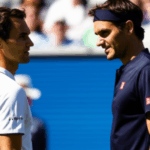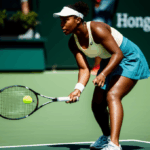Carlos Alcaraz, the young Spanish tennis sensation, has solidified his place among the sport’s elite with a mega-sponsorship deal from Nike. This lucrative agreement, reported to be worth between $15 million and $20 million annually, extends Alcaraz’s partnership with the sportswear giant well into the next decade and places him in an exclusive club alongside legends like Roger Federer and Rafael Nadal. Meanwhile, Emma Raducanu’s status with Nike and other brands is under scrutiny as she navigates the challenges of maintaining her marketability amidst fluctuating on-court performance.
Alcaraz’s Nike Deal: A Testament to His Rising Star
Alcaraz’s new deal with Nike is not just a simple endorsement; it’s a statement. The agreement reportedly includes the creation of a custom logo for Alcaraz, a privilege previously granted only to Federer and Nadal. This signifies Nike’s belief in Alcaraz’s potential to become the next global icon of tennis.
Key Highlights of Alcaraz’s Nike Deal:
- Duration: Multi-year contract extending until the middle of the next decade.
- Value: Estimated between $15 million and $20 million per year.
- Exclusivity: Custom logo, placing him alongside Federer and Nadal.
- Timing: Signed before his French Open victory.
Alcaraz has been with Nike since 2019, and the partnership has coincided with his meteoric rise to the top of the tennis world. With three Grand Slam titles already under his belt (US Open 2022, Wimbledon 2023, French Open 2024) and the youngest year-end world number one in ATP history, Alcaraz’s star power is undeniable.
Alcaraz’s Other Endorsements
Nike is Alcaraz’s largest sponsor. However, he also has deals with:
- Rolex
- Babolat
- BMW
- ElPozo
- Isdin
- Turismo de Murcia
- Louis Vuitton
- Calvin Klein
In April 2024, Alcaraz launched the Carlos Alcaraz Garfia Foundation, aimed at improving the lives of disadvantaged children.
Emma Raducanu: Navigating the Complexities of Sponsorship
Emma Raducanu’s story is one of overnight stardom followed by the challenges of living up to immense expectations. After her historic US Open victory in 2021, Raducanu became a sought-after brand ambassador, signing deals with numerous high-profile companies.
Raducanu’s Current Sponsorship Portfolio:
- Nike: Provides match and training kit.
- Wilson: Racket sponsor.
- Dior: Luxury fashion ambassadorship.
- Tiffany & Co.: Jewelry ambassadorship.
- Evian: Beverage endorsement.
- British Airways: Brand ambassadorship.
- HSBC: Financial services partnership.
- Porsche: Global brand ambassadorship.
While Raducanu still maintains a strong portfolio of endorsements, her journey hasn’t been without its bumps. In early 2025, Vodafone, a major telecommunications company, opted not to renew its partnership with Raducanu, reportedly due to her “demanding too much money.”
Challenges and Scrutiny
Raducanu’s career has faced scrutiny due to frequent coaching changes, injuries and fluctuations in rankings. Some critics, including tennis legend Chris Evert, have suggested that the pressure of endorsements may have hindered Raducanu’s on-court development.
Evert stated that Raducanu was “thrown into the deep end” after her US Open win, adding that the endorsements and constant changes in coaching have created unrealistic expectations.
The Impact of Sponsorship on Tennis Careers
The cases of Alcaraz and Raducanu highlight the complex relationship between sponsorship and athletic performance. While lucrative endorsement deals can provide financial security and open doors to new opportunities, they also come with added pressure and expectations.
Benefits of Sponsorship:
- Financial support for training and travel
- Access to top-of-the-line equipment and resources
- Increased brand awareness and marketability
Potential Drawbacks:
- Pressure to perform and maintain marketability
- Distractions from training and competition
- Potential for conflicts of interest
For young athletes like Alcaraz and Raducanu, managing these factors is crucial for long-term success.
Nike’s Strategy: Investing in the Future of Tennis
Nike’s investment in Carlos Alcaraz reflects a broader strategy of identifying and supporting the next generation of tennis stars. By aligning with young talents who demonstrate both exceptional skill and marketability, Nike aims to maintain its dominance in the tennis apparel and equipment market.
Key Elements of Nike’s Tennis Strategy:
- Identifying Rising Stars: Recognizing and supporting promising young players early in their careers.
- Creating Signature Logos: Building brand recognition and associating athletes with the Nike brand.
- Long-Term Partnerships: Establishing long-lasting relationships with athletes to maximize their brand value.
As Rafael Nadal approaches the end of his illustrious career, Nike is strategically positioning Carlos Alcaraz as the future face of its tennis division.
The Road Ahead for Alcaraz and Raducanu
Carlos Alcaraz’s future looks bright. With a new Nike deal and a growing list of accomplishments, he is poised to become one of the biggest stars in tennis. His partnership with Nadal in the Olympic doubles will serve as a symbolic passing of the torch between the two Nike athletes.
Emma Raducanu faces a different set of challenges. After a series of injuries and coaching changes, she is working to regain her form and climb back up the rankings. While her sponsorship portfolio remains strong, her long-term marketability will depend on her ability to translate her off-court success into on-court results.
Ultimately, the stories of Alcaraz and Raducanu offer valuable lessons about the rewards and challenges of navigating the world of sports sponsorship. While Alcaraz rides the wave of his recent successes, Raducanu strives to reclaim her status as a top contender, both athletes must carefully balance their commercial opportunities with the demands of their sport to achieve lasting success.








No Comment! Be the first one.